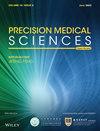The application of metabolomics toward idiopathic pulmonary fibrosis and potential metabolomic value of diverse samples in interstitial lung diseases
IF 0.6
Q4 MEDICINE, RESEARCH & EXPERIMENTAL
引用次数: 0
Abstract
Abstract Interstitial lung diseases (ILDs), also known as diffuse lung diseases, pose a significant challenge to the respiratory health of individuals worldwide. Among these conditions, idiopathic pulmonary fibrosis (IPF) is one of the most prevalent, contributing substantially to morbidity and mortality. However, IPF is characterized by high heterogeneity, presenting a substantial obstacle to clinical program development and scientific research due to significant variations in disease progression, treatment response, and prognosis. Recent advances in metabolomics have enabled the identification of specific biochemical pathways and disease biomarkers, offering a beacon of hope for patients afflicted with various diseases. Remarkably, metabolomics has made significant strides in ILDs, particularly in IPF. Metabonomics, a branch of life science, provides an in‐depth analysis of metabolic pathways and the specific biological molecular composition of omics, obtained primarily from biological samples such as serum, plasma, pleural effusion, bronchoalveolar lavage fluid, lung surgical biopsy samples, urine, feces, sputum, and cerebrospinal fluid. In this review, we aim to provide a comprehensive overview of the application of metabolomics in ILDs, with a particular focus on IPF. By summarizing the current state of research in this field, we hope to shed light on the latest advances, challenges, and opportunities that metabolomics can provide in managing ILDs.代谢组学在特发性肺纤维化中的应用及其在肺间质性疾病中不同样本的潜在代谢组学价值
间质性肺疾病(ILDs)又称弥漫性肺疾病,是全球个体呼吸健康面临的重大挑战。在这些疾病中,特发性肺纤维化(IPF)是最普遍的疾病之一,是导致发病率和死亡率的主要原因。然而,IPF的特点是高度异质性,由于疾病进展、治疗反应和预后的显著差异,给临床项目开发和科学研究带来了实质性障碍。代谢组学的最新进展使得能够识别特定的生化途径和疾病生物标志物,为各种疾病患者提供了希望的灯塔。值得注意的是,代谢组学在ild,特别是IPF方面取得了重大进展。代谢组学是生命科学的一个分支,它提供了对代谢途径和组学的特定生物分子组成的深入分析,主要来自于生物样本,如血清、血浆、胸腔积液、支气管肺泡灌洗液、肺手术活检样本、尿液、粪便、痰和脑脊液。在这篇综述中,我们旨在全面概述代谢组学在ild中的应用,特别关注IPF。通过总结这一领域的研究现状,我们希望阐明代谢组学在管理ild方面的最新进展、挑战和机遇。
本文章由计算机程序翻译,如有差异,请以英文原文为准。
求助全文
约1分钟内获得全文
求助全文

 求助内容:
求助内容: 应助结果提醒方式:
应助结果提醒方式:


